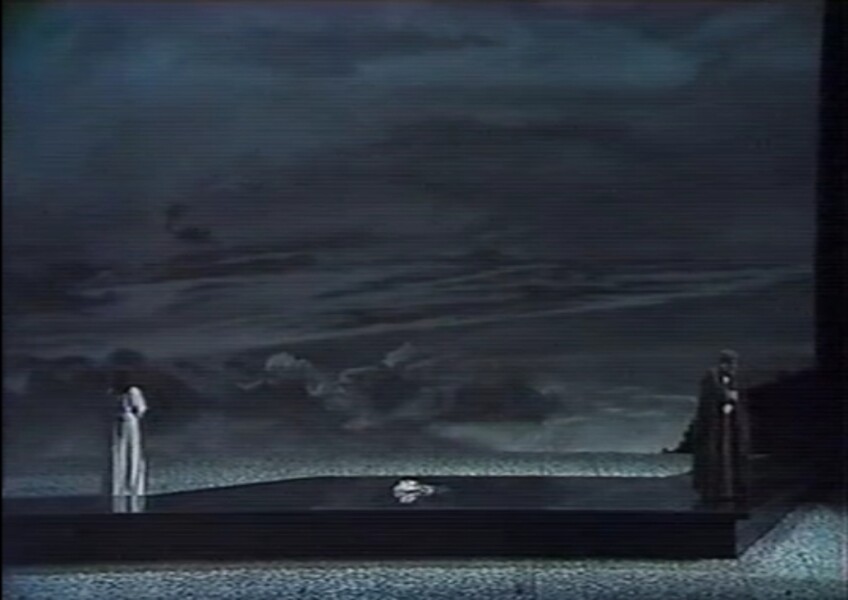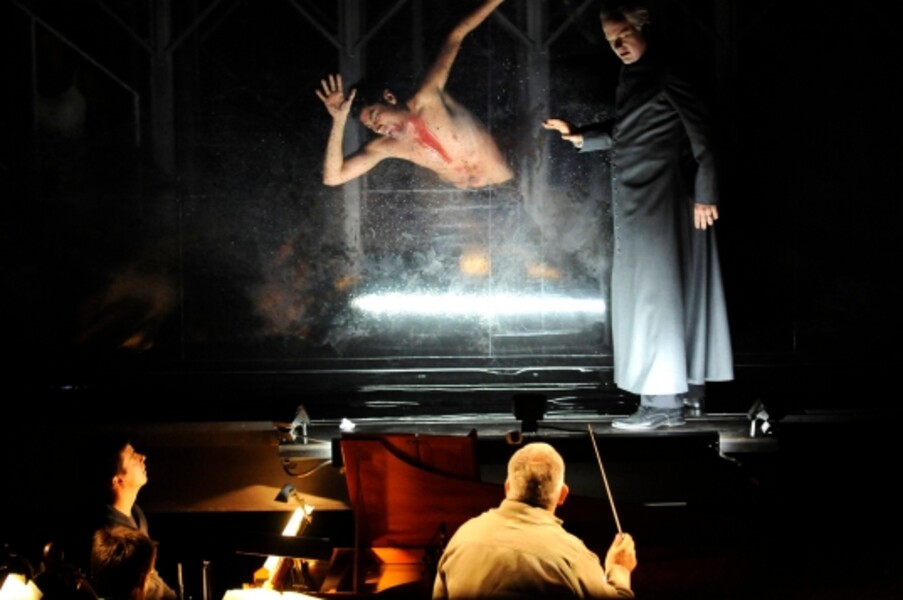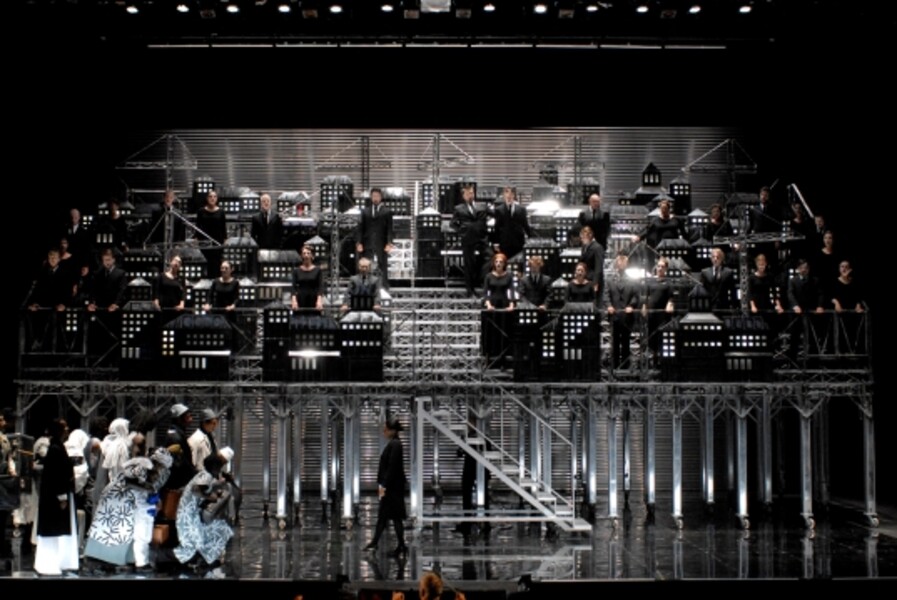MOZART’S IDOMENEO: A [RE-]PREMIERE
Share
This year, the Festival is offering a new production of Mozart’s Idomeneo, Re di Creta (1781). It is being staged by Satoshi Miyagi — an internationally renowned Japanese stage director, who combines Eastern and Western theatrical traditions, and whose Idomeneo is the first opera he has staged in Europe — and conducted by Raphaël Pichon — director of the Pygmalion ensemble, a loyal friend of the Festival, and a conductor who is celebrated for his interpretations of ancient and classical music. This is only the fourth production of this rare work offered by the Festival d’Aix since the Festival was founded in 1948.
Aix-en-Provence is the French arena of choice for re-introducing Mozart to the general public. Some of the Austrian composer’s works had already been rediscovered by audiences a first time during the interwar period, but were often performed in an abridged or partial form, in French instead of German or Italian. The Festival carried on this musical resurrection after World War II. Quickly forgotten after its premiere, rediscovered at the turn of the twentieth century — notably by Strauss — and then again at the beginning of the 1950s at Salzburg and Glyndebourne, Idomeneo became a part of the Festival’s Mozartian canon in 1963. The Festival d’Aix then became a musical laboratory for work on Idomeneo, and more broadly on Mozart’s entire operatic oeuvre, in particular by entrusting the musical direction to orchestras or ensembles specialised in the interpretation of music from the Classical period.
1963–1966: GIVING NEW LIFE TO IDOMENEO
Gabriel Dussurget, founder and artistic director of the Festival from 1948 to 1972, wanted to give new life to Mozart’s opera seria in Provence. The production was a great success, and was reprised in 1966. Each time, Peter Maag conducted the Concerts Colonne orchestra. The Swiss conductor, who was at the beginning of his career as a great conductor of Mozartian operas, revived Mozart’s score for the Aix audience, in a version that was nevertheless slightly abridged. Suzanne Lalique designed the sets for this first production of Idomeneo at the Festival. The large articulated dragon that emerges from the waves during the second act was without a doubt the emblematic object for the work. The young artist had made a name for herself in painting and in set design in the interwar period; in particular, she had designed the set for productions staged by Jean Meyer at the Comédie Française. At the Festival d’Aix, Gabriel Dussurget asked her to work on Purcell’s Dido and Aeneas (1960), Monteverdi’s Il combatimento and L’incoronazione di Poppea (1961), and then Idomeneo.
In Idomeneo, Mozart composed two moments of ballet: an intermezzo and a final ballet. In 1963, George Skibine, ballet master at the Opéra de Paris and former dancer for Ballets Russes, choreographed the intermezzo of Act 1. It wasn’t the only time heirs to the Ballets Russes participated in the Festival: Gabriel Dussurget had a decided taste for dance styles and companies he had discovered through his work at the Théâtre des Champs-Élysées. He wanted to make Aix a melting pot for artistic modernity and recreate this intermingling of plastic arts, music and dance.
1986: IDOMENEO’S FIRST FORAY INTO THE FAR EAST
In 1986, Louis Erlo —director of the Festival from 1982 to 1996, and concomitantly director of the Opéra de Lyon and the Opéra Studio of the Opéra de Paris — put on a new version of the work. It was conducted by Hans Graf, an expert in Mozart and head of the Mozarteum in Salzburg at the time. The stage director was Pierre Strosser, who offered a streamlined set design loosely based on the Noh theatre. On a long inclined plane that represented the shores of Crete, the characters slowly marched. The dramatic tension of Mozart’s music was echoed in the nearly immobile stage direction.

Idomeneo, produced in 1986. Act II, n°11, « Se il padre perdei », Sylvia Greenberg and Philip Langridge.
Patrice Cauchetier designed costumes inspired by Korean styles, and thereby extended the Asian universe evoked by Pierre Strosser. Patrice Cauchetier is one of the leading costume designers of his generation, and has a special talent for creating theatrical costumes that are credible, rooted in their era, and historically informed. His work for Idomeneo is an excellent example of his talent. This year, with Satoshi Miyagi’s stage direction, Idomeneo will join the imaginary dimension of the Far East for a second time, with influences from Korea in 1986 and from Japan in 2022.

Patrice Cauchetier, costumes model for Idomeneo, 1986. Fonds du Festival international d'art lyrique d'Aix-en-Provence, Ville d'Aix-en-Provence - Musée des Tapisseries, donation of the artist.
2009: IDOMENEO BY OLIVIER PY
In 2009, Bernard Foccroulle was the next person to programme Idomeneo: he entrusted the musical direction to the Musiciens du Louvre, under the baton of Marc Minkowski.

Idomeneo by Mozart in Olivier Py's staging - Richard Croft (Idomeneo), conducted by Marc Minkowski - Festival d'Aix-en-Provence 2009 © Elisabeth Carecchio
In an impressive set designed by Pierre-André Weitz — a veritable “cosmogony on three levels” — Olivier Py treated Idomeneo’s mythological theme as a social issue. The conflict between Idamante and his father echoed the subconscious malaise of the post-1968 generation, who were bewildered by the arbitrary orders of their elders. The chorus, who performed under large scaffolding, amplified the familial tragedy that was unfolding above them.

Idomeneo de Mozart in Olivier Py's staging - RIAS Kammerchor in a set by Pierre Weitz - Festival d'Aix-en-Provence 2009 / © Elisabeth Carecchio
Anne Le Berre